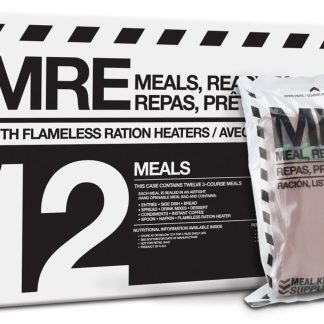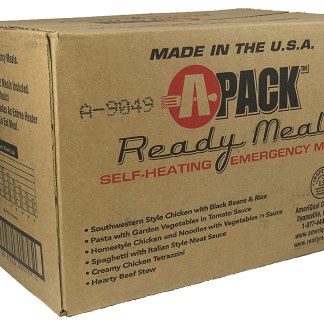MRE’s Are Amazing!
Why We Love MRE’s
Convenient & Shelf Stable Meals
MRE’s are designed to survive pretty much any environment, typically being packed in waterproof and airtight containers. They are light for the amount of nutrition they provide. And you can store them pretty much anywhere you want (they last longer when stored in colder temps) and forget about them until needed. Shelf life can be anywhere from 2-10+ years.
Like a Mini Survival Kit
In a survival situation, MRE’s aren’t the ONLY thing we’d want, but having a few would be a huge help. That’s because besides the food they often have other necessities such as stoves with fuel (or heater pack), water purification, toilet paper, matches, toothbrush and cleaning wipes. They also don’t need to be rehydrated, so if you don’t have clean water at hand, you can still enjoy a meal.
They Taste Good! ?
There are plenty of jokes about the palatability of MRE’s in the past and we can say that contrary to popular belief the quality of most MRE’s is really good. Not only do they taste great but these things are designed for extreme environments and to provide great nutrition. Soldiers burn tons of calories and an MRE is designed with a perfect balance of protein, carbohydrates, fat, and electrolytes. They often have some short term performance enhancers like chocolate or caffeine. There is even a pizza MRE now. Seriously!

MRE’S ARE A GREAT VALUE!
Because they are so calorie dense – with a single MRE meal packing at least 1,200 calories for a packing weight of about 1.3 pounds – MRE’s represent a great value when they cost the same or less than a comparable fast food meal. For the same price you get a lightweight, portable, shelf stable, nutritious and convenient meal that you can enjoy hot, anywhere!
THEY ARE SUPER CONVENIENT
Ever stager into camp after a long day on the trail, overwhelmed by simply the thought of having to set up the tent, much less cook a meal? Sure you could gather firewood into the night and find some water to mix with that freeze dried meal. Or, you could just tear open an MRE, place it in the heater pouch and enjoy a hot meal in basically seconds. I’m not saying I’d like to eat them every night, but sometimes they are the best option going.

MREs: A Convenient, Compact, and Long-lasting Meal for Your Outdoor Adventures
Meals Ready to Eat, more commonly known as MREs, are self-contained meal kits designed to provide nutrition for individuals in situations where traditional food service is not available. These portable meals are known for their long shelf life and ease of preparation, making them a popular choice among military personnel, disaster relief workers, and outdoor enthusiasts.
The Concept of MREs:
An MRE typically consists of an entree, a side dish, bread or crackers, spread (like cheese, peanut butter, or jelly), dessert, candy, and beverages. These meals also come with flameless ration heaters (FRH), which use a simple chemical reaction to heat the meal without the need for a fire or stove. This compact, all-in-one design ensures that consumers receive a variety of essential nutrients, regardless of their circumstances.
A Brief History of MREs:
The concept of MREs was introduced by the U.S. military. During the Civil War, soldiers were given hardtack, a type of hard, dry biscuit that could be carried easily and would last for months, even years. This, however, lacked variety and essential nutrients.
In World War II, the U.S. military developed C-rations (combat rations) and K-rations. These were small, portable meals, but they had limited menu options and were not intended for long-term use.
The MRE as we know it today was introduced in 1981. With the ongoing advances in food preservation technology, the U.S. Department of Defense was able to develop meals that were lightweight, had a long shelf life, and could be eaten hot or cold. Over the years, MREs have been improved to include a wider variety of meals and better-tasting food.
MREs for Hiking and Hunting:
MREs can be a practical choice for hikers and hunters. Here are some reasons why:
- Portability: MREs are compact and lightweight, which makes them easy to pack and carry in a backpack.
- Shelf Life: Most MREs have a shelf life of 3 to 5 years, meaning they can be stored for long periods before use.
- Variety: Today’s MREs come in a wide range of flavors, from traditional meat dishes to vegetarian and international cuisine.
- No Cooking Required: MREs can be eaten cold, or heated using the included FRH. This makes them a convenient meal option, particularly in environments where fire or cooking equipment is not available.
However, it’s also important to note some potential drawbacks of MREs:
- Taste: While MREs have improved significantly in taste over the years, they may not be as flavorful as fresh food or restaurant meals.
- Nutritional Balance: MREs are designed for high-intensity situations, like providing a soldier the nutrition they need and thus can be high in calories and sodium, which might not be suitable for everyone.
- Cost: MREs are generally more expensive than regular food due to their specialized packaging and long shelf life.
- Waste: The packaging of MREs can create a significant amount of waste, which is not ideal for a leave-no-trace wilderness ethic. That said, the waste is generally light and the pouch makes a handy trash bag for packing it out to a dumpster later.
In conclusion, MREs can be a convenient and versatile meal option for hiking or hunting trips. They are portable, easy to prepare, and have a long shelf life. However, depending on your use, they may not be the best option for everyone. As with any outdoor gear, it’s essential to consider your individual needs and circumstances when choosing your food options.



